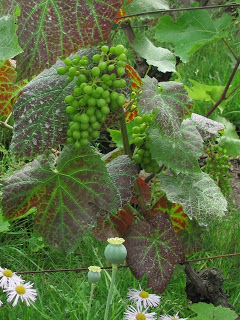
of Paris has a long history of wine-making (and wine drinking), from a Roman temple dedicated to Bacchus to a medieval winery where nuns pressed the grapes, and on into the present-day
cultivation of this old neighborhood vineyard.
The wine harvest is nearing its end, so this seems like a good time to look at the different species of grapes that are used for wine. When I first began to take a serious interest in wine, the differences between varieties and species were very fuzzy to me. I’m still sorting out the varieties, most of which come with fascinating but confusing historical baggage involving different names depending on the place and time.
Species are easier. For starters, all types of wine grapes fall within the genus Vitis, named for the Latin word for grape vine. Within that genus, most wine grapes are varieties of Vitis vinifera, although grapes from this species are also eaten fresh or dried. This species first arose in central Europe, southwestern Asia, and the lands around the Mediterranean. Because yeast occurs naturally on the grape skins, they would ferment if left to themselves. It’s not clear when humans first discovered and exploited the products of fermentation, but they’ve been playing around with grape fermentation for a very long time.
Vinifera translates roughly from Latin as wine-bearing. Note that -fer (meaning carry or bear) is all over the place in other words: transfer (carry across), refer (carry back), Lucifer and phosphor (light-bearer; both used to be names for the morning star), and metaphor (carry over, in the sense of carrying meaning).
Vitis labrusca is a North American species that contains both varieties used for wine and varieties used in juice or jam (for example, the Concord is a V. labrusca variety). Labrusca is the Latin word for a wild grape, and these grapes are noted for a particular earthy musky flavor. The wines they make are very grape-juicy, maybe not ultra-sophisticated but very appealing in their way. Catawba and Niagara are probably the varieties you’re mostly likely to see in wines.
Wines are also made from the North American grape Vitis aestivalis. Aestivales comes from the Latin word for summer, although it’s not clear why that name was given to this species. The cultivar Norton is thought to be the first American grape used in commercial wine production, and it’s still an important grape in Missouri and parts of the eastern US.
Vitis riparia, named from the Latin word for the riverbanks where it likes to grow, is important for wine because it is used as a root stock that provides V. vinifera grapes with genes for cold tolerance, disease resistance, and resistance to phylloxera. Another grape used as root stock is Vitis rupestris; rupestris is a botanical and zoological term that comes from Latin; it means essentially living on or near rocks and appears in other species names as well.
Phylloxera is historically one of the most notable grape pests; it swept through Europe in the late 19th century, inspiring viticulturists to use resistant root stocks and develop hybrids. In the name phylloxera, we once again encounter the Greek root phyllo (leaf), which also appear in chlorophyll and phyllosilicate. The -xera part of the name comes from a Greek word for dry; we also see it in xeroscaping (landscaping in dry areas with native desert plants) as well as xerography and Xerox (the company applied a “dry” process of photographic duplication that did not involve the use of a liquid developer). Phylloxera is a pest that sucks the sap from the roots and leaves of grape plants.
Of course, this simple picture is made tremendously more complex (and more rewarding) by the presence of so many varieties of wine grapes within the species V. vinifera, each suited to a particular climate and soil type, not to mention the existence of many hybrids. But getting into that would take a lifetime.
Learn more:
- Check out Ancient Wine: The Search for the Origins of Viniculture, by Patrick McGovern (find in library).
- For more on the Norton grape, see The Wild Vine: A Forgotten Grape and the Untold Story of American Wine, by Todd Kliman (find in library).